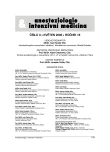Pre-emptive Analgesia with Ketamine and Morphine: a Clinical Study
Authors:
J. Málek 1; A. Kurzová 1; I. Kraus 2
Authors‘ workplace:
Klinika anesteziologie a resuscitace, UK 3. LF a FNKV, Praha
1; Klinika gynekologie a porodnictví UK 3. LF a FNKV, Praha
2
Published in:
Anest. intenziv. Med., 16, 2005, č. 3, s. 138-142
Category:
Anaesthesiology - Original Paper
Overview
Objective:
To assess if a pre-emptive combination of morphine and ketamine is more effective than if one drug is administered before surgery and the second one after a surgical stimulation.
Design:
Prospective single-blinded randomized clinical study.
Setting:
Charles University, Prague, 3rd Medical Faculty, Dept. of Anaesthesiology and Intensive Care.
Material and Method:
A total of 63 women scheduled for abdominal hysterectomy were randomly divided in three equal groups. Only atropine and diazepam were used for premedication. The group K was administered ketamine 0.6 mg . kg-1 + normal saline (NS) i. v. before induction to general anaesthesia (GA) and morphine 0.1 mg . kg-1 10 minutes after laparotomy, the group M was administered morphine 0.1 mg.kg-1 + NS before induction to GA and ketamine 0.6 mg . kg-1 10 minutes after laparotomy and the group MK was administered ketamine 0.6 mg . kg-1 + morphine 0.1 mg . kg-1 i. v. before induction to GA and normal saline 10 minutes after laparotomy. GA and monitoring were performed in a standard way. Post surgery morphine consumption during first and second 24 hours was measured using patient controlled analgesia.
Results:
The morphine consumption during the first 24 hours post surgery was in MK significantly lower then in M, resp. K (22.6 ± 7 mg vs. 30.2 ± 12.1; P < 0.05, resp. 34.1 ± 12.1; P < 0.001). The morphine consumption was lower also during the second 24 hours post surgery in MK vs. M resp. K (13.3 ± 5.4 mg vs. 20.1 ± 9 mg, resp. 22.0 ± 10 mg, both P < 0.01). There were no significant differences in morphine consumption between M and K in any measured interval. There was no case of an insufficient analgesia in any group.
Conclusion:
The combination of the pre-emptive ketamine and morphine administration causes better post-operative analgesia (measured by the morphine consumption after surgery), then when one drug is used before surgery and the other one after surgical stimulus.
Key words:
pre-emptive analgesia – postoperative analgesia – morphine – ketamine
Labels
Anaesthesiology, Resuscitation and Inten Intensive Care MedicineArticle was published in
Anaesthesiology and Intensive Care Medicine

2005 Issue 3
Most read in this issue
- Pre-emptive Analgesia with Ketamine and Morphine: a Clinical Study
- Acetaminophene Intoxication: a Case Report
- Influence of Major Abdominal Surgery on Intra-abdominal Pressure and Perfusion of Splachnic Organs
